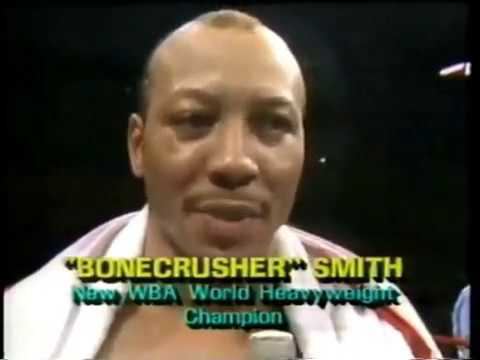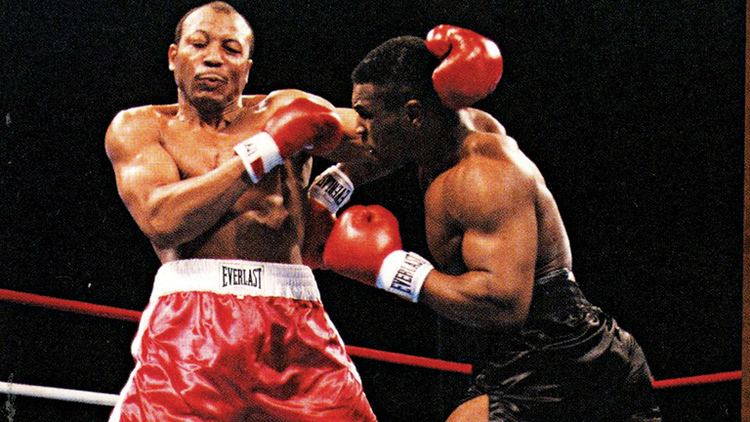Nickname(s) Bonecrusher Wins 44 Height 1.93 m Nationality American Role Boxer Total fights 62 | Reach 82 in (208 cm) Name James Smith Rated at Heavyweight Wins by KO 32 Trained by Emile Griffith | |
 | ||
Born April 3, 1953 (age 72) North Carolina ( 1953-04-03 ) Education | ||
1987 03 07 mike tyson vs james smith full fight
James "Bonecrusher" Smith (born April 3, 1953) is an American former professional boxer who competed from 1981 to 1999, and held the WBA heavyweight title from 1986 to 1987. He was the first heavyweight champion with a college degree.
Contents
- 1987 03 07 mike tyson vs james smith full fight
- James smith vs frank bruno highlights
- Early life
- Amateur career
- Professional career
- Final years
- Life after boxing
- References

James smith vs frank bruno highlights
Early life

Smith was born in Magnolia, North Carolina. After graduating from high school in, he attended James Sprunt Community College in Kenansville, North Carolina, earning an associate's degree in Business Administration in 1973. Two years later, he earned a bachelor's degree in Business Administration from Shaw University in Raleigh, North Carolina.
Amateur career
After serving in the US military and working as a prison guard, Smith competed as an amateur compiling a record of 35-4, before turning professional in November 1981, at the late age of 28.
Professional career
He lost his first fight against James "Broad-Axe" Broad, a world class amateur and qualifier for the 1980 Olympics who was 2–0 as a pro. The fight was broadcast on ESPN, and Smith had come in at short notice and was not in great shape, looking out of depth against the skilled Broad. Smith was dropped in 4 rounds with body shots, and counted out.
The following year Smith upset future cruiserweight world champion and southpaw Ricky Parkey, then 2–0 as a pro, by winning a 6-round points decision. After scoring two knockouts, Smith followed up the Parkey win with another upset, an 8-round points decision over Chris McDonald, who was 8–0–1 as a pro and had been a top amateur. He went on to score nine straight knockouts, before traveling to the UK in 1984 to fight a world title eliminator against the hard hitting undefeated British prospect Frank Bruno, who was 21–0 (21 KO). Once again Bonecrusher would throw a spanner in the works. Having been outboxed with relative ease by Bruno for the first nine rounds, he unleashed a salvo of power punches to KO Bruno in the tenth and final round, and qualified for a world title shot. The fight showed all his strengths and weaknesses — he couldn't box with the best, but had a great chin and world class power in both hands.
In November 1984 he fought the long reigning Larry Holmes for the IBF heavyweight championship. Holmes had a record of 45–0 and had won eighteen straight world title fights. After rocking Holmes several times, a waning Smith was stopped on advice of the doctor in the 12th round, due to a bad cut. He again was behind on points.
Smith came back in 1985 relegated to fighting on Don King undercards. He lost a 10-round decision to 19–0 amateur star and future world champ Tony Tubbs in an eliminator, won a 10-round decision over 18–1 Cuban contender Jose Ribalta, but then he dropped a wide 12-round decision to ex-world champ Tim Witherspoon in a bid for Witherspoon's NABF belt.
1986 started no better as he dropped Marvis Frazier, also breaking Frazier's jaw, but still lost the 10-round decision. At this time Bonecrusher began consulting a psychiatrist. In his next fight he demolished hard-punching ex-world champ Mike Weaver in one round. He followed it up with two 10-round decisions over Jesse Ferguson (14–2) and David Bey (15–2), arguably his most important decision wins.
In December 1986, while preparing for a fight with the erratic Mitch "Blood" Green, Don King informed him at short notice that Tony Tubbs had dropped out of his upcoming challenge to reigning WBA champ Tim Witherspoon, and now Smith would be getting a rematch with his former conqueror, his second world title fight. Knowing of Witherspoon's mental weariness and lack of passion due to a never ending legal war with King, Smith came out fast. He dropped the usually durable Witherspoon three times in the opening round, scoring a first-round knockout and winning the WBA title in an upset.
With his surprising victory over Witherspoon, Smith took his place in an ongoing competition being conducted by HBO and King to try to crown an undisputed world heavyweight champion for the first time since the retirement of Muhammad Ali. The victory garnered Smith another high-profile fight, where he was to defend his belt against newly crowned WBC champion Mike Tyson in a unification contest. Taking place on March 7, 1987, the bout saw Tyson beat Smith to the punch in nearly every round while Smith resorted to holding to keep himself in the fight. The lopsided decision saw Smith lose eleven rounds on two scorecards and all twelve on another, and the professional consequences were worse as Tyson's management refused to allow Smith to fight on any Tyson undercards afterwards.
Final years
He returned to the ring for a few months. He took on Brazilian contender Adilson "Maguila" Rodrigues in São Paulo, but dropped a very controversial decision.
In 1989, now aged 36, he took on the young power-punching Jamaican-Canadian Donovan (Razor) Ruddock. Smith's own punch power was still evident as he decked Ruddock hard in the 2nd round, but seemed to punch himself out trying to finish Ruddock, who was a crafty survivor. The next few rounds saw Smith tire, as Ruddock's youth and power overwhelmed him, knocking him clean out in the 7th round for the full 10 count. Ruddock would go on to become a star and feature in several high-profile fights. Smith's career appeared to be over. He announced his retirement after the loss and said he would now pursue politics.
Smith was back in the ring only two months later, KOing journeyman Calvin Jones jaw and followed up with three more knockouts before being matched with former victim Mike Weaver in a battle of hard hitting ex-champs. This time Smith was resigned to having to win a dull 12 round points decision over Weaver, although he did score a knockdown in a brief moment of excitement. He also earned the superfluous WBA Americas belt, and a world ranking.
After a year layoff he was back, now aged 38, and scored six knockouts, including a notable 8-round knockout of the cement-skulled journeyman Everett (Bigfoot) Martin (who had just taken George Foreman the distance), and a first-round knockout of equally hard hitting ex-contender Jeff Sims.
However he lost his world ranking and all his momentum in November 1991 when he dropped a shocking 10-round decision to club fighter Levi Billups who had a patchy 15–5 record. Smith looked under-prepared as he was banged around and generally outhustled by Billups. He rallied to knock down the underdog in the 9th, however it was too little too late.
Still active in 1992, now aged 39 and with a 33–9–1 record, Smith regained some credibility with a 10-round decision over Mark Wills. His old agitator Don King gave him another opportunity on one of his undercards and matched him with fellow aging warhorse Greg Page, in a battle of two ex-champs. In the opening round Bonecrusher tried to rush Page as he had done Witherspoon, however was decked himself for his efforts, and was outpunched easily by Page over the 10 round distance.
In 1993 Smith lost to undefeated southpaw and #1 contender Michael Moorer. The paying audience jeered the two passive fighters through to the 10 round finish, where Smith lost a lopsided decision.
It seemed at this point Smith was boxing now purely for the payday. He competed in the One-Night Heavyweight Tournament in Bay St Louis (not included in the official record, counted as show), where a group of heavies of varying quality would fight a series of 3 round fights with the winner being awarded one million dollars. He beat Lester Jackson and Marshall Tillman, before losing in the semi-final to Romanian prospect Daniel Dăncuţă. Smith's old buddy Tony (TNT) Tubbs eventually won.
In 1994 he was matched with power punching Tyson-lookalike Lionel Butler, who was highly ranked and on a red hot string of knockouts. Smith collapsed in 3 rounds, having offered little resistance.
Later that year he traveled to Europe to drop a points decision to German Axel Schulz, and in Denmark he was stopped in 5 rounds due to a cut from a headbutt, courtesy of Brian Nielsen. Smith was overweight for both of these fights, and his days as a contender were definitely over.
He fought on and off for a few more years. In 1998 he traveled to Australia to battle fellow relic Joe Bugner for an obscure belt, but had to retire after one round when his shoulder popped out. The same injury ended a fight in 1999 with yet another aged fighter, old buddy Larry Holmes. After this Smith finally saw sense and hung up the gloves, aged 46 and with a record of 44–17–1 (32 KOs).
In 1995, James helped establish the North Carolina Boxing Commission. He served as its first chairman.
Life after boxing
Smith became an ordained minister in 1996 and dedicated his life to helping young people stay clear of crime and drugs. Three years later, he retired from boxing.
In 2004 Smith started the non-profit organization Champion For Kids Inc. to provide scholarships to high school students.
Smith began working as a recruiter and the Director of Intramural Athletics for Sandhills Community College in June 2005.
He now works for the Working Families Party in New York City. He now lives in Myrtle Beach South Carolina.
Deeply committed to helping impoverished fighters, Smith was a guest at the Ring 10 Veterans Boxing Foundation 2nd Annual Fundraiser in 2012 where he expressed his support of initiatives to better provide for those in need.
